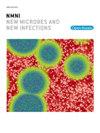Prevalence and genotyping of human papillomavirus DNA in peripheral blood mononuclear cells from blood donors in Iran
IF 5.4
Q2 INFECTIOUS DISEASES
引用次数: 0
Abstract
Introduction
Human papillomavirus (HPV) is one of the most common sexually transmitted infections. In addition to sexual transmission, papillomavirus can also be transmitted through surfaces, autoinoculation and vertical transmission. Limited studies have also indicated the presence of HPV DNA in the blood of healthy individuals. The aim of this study was to investigate the prevalence of DNA in peripheral blood mononuclear cells (PBMCs) of blood donors of Ilam city-Iran.
Material and methods
We explored the prevalence of HPVs in 108 (58 males and 50 females) blood donors. DNA was extracted from the buffy coat, and genotyping was performed by sequencing after generic nested-PCR detection procedure using MY09/11 and GP5+/6+ primers targeting L1 region in HPV genome.
Results
HPV DNA was detected in 11 out of 108 samples (10.18 %). Genotype 16 was identified in 3 cases, followed by genotype 6 in 2 cases and genotypes 11, 31, 35, 51, 53, 59 each in one case. The positive cases included 4 men and 7 women, and their ages ranged from 25 to 37 years.
Conclusion
HPV DNA was detected in PBMCs of asymptomatic blood donors. These results support the concern about blood transfusion as a potential source of HPV transmission and need for future studies.
伊朗献血者外周血单个核细胞中人乳头瘤病毒DNA的流行率和基因分型
人乳头瘤病毒(HPV)是最常见的性传播感染之一。除性传播外,乳头瘤病毒还可通过表面传播、自身接种和垂直传播。有限的研究也表明健康人血液中存在HPV DNA。本研究旨在调查伊朗伊拉姆市献血者外周血单个核细胞(PBMCs)中DNA的流行情况。材料和方法我们调查了108名献血者(男性58名,女性50名)hpv的患病率。利用MY09/11和针对HPV基因组L1区的GP5+/6+引物,采用通用巢式pcr检测程序进行测序分型。结果108份标本中11份检出shpv DNA,检出率为10.18%。16基因型3例,6基因型2例,11、31、35、51、53、59基因型各1例。阳性病例男4例,女7例,年龄25 ~ 37岁。结论在无症状献血者外周血中检测到人乳头瘤病毒DNA。这些结果支持了输血作为HPV传播的潜在来源的担忧和未来研究的必要性。
本文章由计算机程序翻译,如有差异,请以英文原文为准。
求助全文
约1分钟内获得全文
求助全文
来源期刊

New Microbes and New Infections
Medicine-Infectious Diseases
CiteScore
10.00
自引率
2.50%
发文量
91
审稿时长
114 days
 求助内容:
求助内容: 应助结果提醒方式:
应助结果提醒方式:


